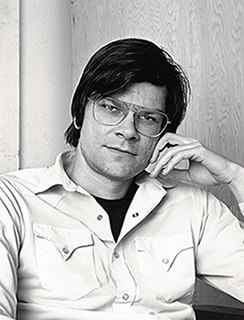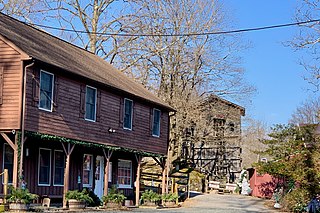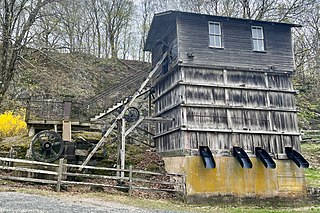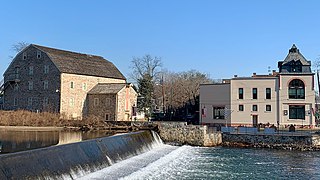
Clinton is a town in Hunterdon County, New Jersey, United States, located on the South Branch of the Raritan River in the Raritan Valley region. As of the 2010 United States Census, the town's population was 2,719, reflecting an increase of 87 (+3.3%) from the 2,632 counted in the 2000 Census, which had in turn increased by 578 (+28.1%) from the 2,054 counted in the 1990 Census. Despite its relatively small population, Clinton is the predominant control city for Interstate 78 heading west from Newark.

Robert Smithson was an American artist known for sculpture and land art who often used drawing and photography in relation to the spatial arts. His work has been internationally exhibited in galleries and museums and is held in public collections including the Museum of Modern Art, New York, the Smithsonian American Art Museum, Solomon R. Guggenheim Museum, New York, the Tate Modern, London, the Whitney Museum of American Art, New York, among others. He was one of the founders of the Land Art movement whose best known work is the Spiral Jetty.

The Hudson River School was a mid-19th century American art movement embodied by a group of landscape painters whose aesthetic vision was influenced by Romanticism. The paintings typically depict the Hudson River Valley and the surrounding area, including the Catskill, Adirondack, and White Mountains. Works by the second generation of artists associated with the school expanded to include other locales in New England, the Maritimes, the American West, and South America.
John Brewster Jr. was a prolific, Deaf itinerant painter who produced many charming portraits of well-off New England families, especially their children. He lived much of the latter half of his life in Buxton, Maine, USA, recording the faces of much of Maine's elite society of his time.
Toshiko Takaezu was an American ceramic artist and painter.

Quakertown is an unincorporated community located within Franklin Township in Hunterdon County, New Jersey. It was once known as Fairview. The area was settled by Quakers from Burlington County, who organized a meeting house here in 1733. The Quakertown Historic District was listed on the state and national registers of historic places in 1990.
Theodore Clement Steele was an American Impressionist painter known for his Indiana landscapes. Steele was an innovator and leader in American Midwest painting and is one of the most famous of Indiana's Hoosier Group painters. In addition to painting, Steele contributed writings, public lectures, and hours of community service on art juries that selected entries for national and international exhibitions, most notably the Universal Exposition (1900) in Paris, France, and the Louisiana Purchase Exposition (1904) in Saint Louis, Missouri. He was also involved in organizing pioneering art associations, such as the Society of Western Artists.
The Contemporary Museum, Honolulu is now part of the Honolulu Museum of Art, and is called the Honolulu Museum of Art Spalding House. It was the only museum in the state of Hawaii devoted exclusively to contemporary art. The Contemporary Museum had two venues: in residential Honolulu at the historic Spalding House, and downtown Honolulu at First Hawaiian Center. All venues continue to be open to the public.

The Racine Art Museum (RAM) and RAM's Charles A. Wustum Museum of Fine Arts are located in Racine, Wisconsin, U.S. The museum holds the largest and most significant contemporary craft collection in North America, with more than 9,500 objects from nationally and internationally recognized artists. The Racine Art Museum's mission is to exhibit, collect, preserve, and educate in the contemporary visual arts. Its goal is to elevate the stature of craft to fine arts by presenting contemporary crafts alongside paintings and sculptures.
Martin Beck is an American painter who live and works in Lexington, Kentucky.

Valeri Larko is an American painter of urban and industrial landscapes. She is known for her cityscapes, painted en plein air.

The Red Mill is a 4-story grist mill located along the South Branch Raritan River at 56 Main Street in Clinton, New Jersey. It was built c. 1810 as an industrial mill. It has served several roles, including a wool processing plant, a peach basket factory, and a textile mill. Historically known as the David McKinney Mill, it was added to the National Register of Historic Places on January 8, 1974 for its significance in agriculture and commerce. In 1995, it was also listed as a contributing property of the Clinton Historic District. It is now part of the Red Mill Museum Village, an open-air museum previously known as the Clinton Historical Museum.

The Red Mill Museum Village, historically known as the Clinton Historical Museum, is an open-air museum located along the South Branch Raritan River at 56 Main Street in Clinton, New Jersey. It includes the historic Red Mill and the adjacent M. C. Mulligan & Sons Quarry. The museum is a private, non-profit organization, whose mission is to display the social, agricultural, and industrial heritage of Hunterdon County. The 10 acres (4.0 ha) site has 12 historic buildings. Both the mill and the quarry are listed on the National Register of Historic Places and are part of the Clinton Historic District.
Zulma Steele (1881–1979) was one of the pioneering women of the Arts and Crafts movement and Modernism in New York. American arts journalist for the New York Times Grace Glueck noted that Steele was a "progressive-minded artist and artisan whose work was considered avant-garde." She married a farmer, Nielson Parker, in 1926. After he died in 1928, Steele traveled extensively in Europe, Haiti, and the Bahamas. She returned to upstate New York and died in New Jersey at 98 years of age.

Anne Steele Marsh (1901–1995) was an American painter and printmaker whose watercolors, oil paintings, and wood engravings were widely exhibited and drew critical praise. She was also a noted educator and arts administrator.
James Randall Marsh (1896–1966) was an American artist and the husband of Anne Steele Marsh.

The M. C. Mulligan & Sons Quarry is a 8.8-acre (3.6 ha) historic district encompassing a former limestone quarry located at 56 Main Street in the town of Clinton in Hunterdon County, New Jersey. It was added to the National Register of Historic Places on August 30, 1994, for its significance in agriculture, commerce, and industry. The listing includes six contributing buildings, two contributing structures, a contributing object, and a contributing site. In 1995, it was also listed as part of the Clinton Historic District. The quarry is now in the Red Mill Museum Village, an open-air museum.
Jim Toia is an American studio artist and professor of art.

Dunham's Mill, also known as Parry's Mill, is a historic building located at 7 Lower Center Street in Clinton, New Jersey, United States. The gristmill was in operation from 1837 to 1952. It was added to the National Register of Historic Places on April 15, 1982, for its significance in commerce and industry. In 1995, it was also listed as a contributing property of the Clinton Historic District. It shares the Clinton Dam across the South Branch Raritan River with the David McKinney Mill on the other side of the river. Since 1952, it has been home to the Hunterdon Art Museum, described by an art critic as the "most charming and picturesque" museum in the state.

The Clinton Historic District is a 175-acre (71 ha) historic district encompassing much of the town of Clinton in Hunterdon County, New Jersey. It was added to the National Register of Historic Places on September 28, 1995, for its significance in architecture, commerce, engineering, industry and exploration/settlement. The district includes 270 contributing buildings, one contributing structure, and three contributing sites. Five were previously listed on the NRHP individually: Dunham's Mill, M. C. Mulligan & Sons Quarry, Music Hall, Old Grandin Library, and Red Mill.















